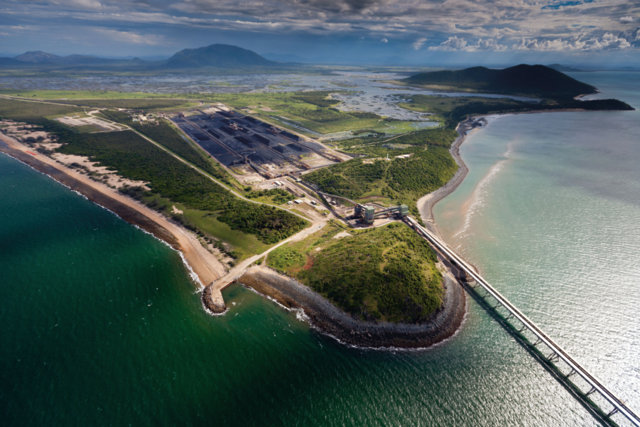
The Adani Abbot Point Terminal Pty Ltd (Abbot Point), a coal export terminal near the Great Barrier Reef in Australia, was the case studied in (Mis)Calculated Risk, which illustrated how rating agencies are failing to incorporate a dynamic change trajectory and thus these agencies could repeat some of the same mistakes that led to the global credit crisis of 2008. As (Mis)Calculated Risk explained, Moody’s applied its generic project finance methodology to issue Abbot Point a Baa3 rating (an investment-grade rating), thus giving a “thumbs-up” to investors. Embedded in Moody’s endorsement of Abbot Point, however, were two assumptions that have proven problematic in the months since (Mis)Calculated Risk was released:
First, Moody’s assumed that any softening in coal demand would not be so severe so as to affect the long-term commercial viability and competitive position of the terminal; and
Second, Moody’s relied on Abbot Point’s “take-or-pay” contracts—contracts that require coal producers to either “take,” e.g., use the port capacity that they contracted for, or “pay” for it. Moody’s assumed that the take-or-pay contracts would provide the cash flow stability necessary to insulate Abbot Point from other credit risks.

While these assumptions could be reasonable under a status quo approach, they are unreasonable in the context of a dynamic climate change trajectory. These assumptions are especially problematic in light of the fact that Abbot Point was only operating at 57% of its port capacity in fiscal year 2014-2015. Thus, much of the revenue that Abbot Point was counting on to service its debt was coming from coal producing companies who weren’t “taking” their port capacity and thus had to “pay” for nothing. Abbot Point’s capacity is unlikely to recover any time soon in light of the continued softening of coal demand and the further deterioration of coal producing companies.
First, coal demand is softening under a dynamic climate change trajectory.
Limiting global warming isn’t an empty promise. Under a 2°C climate scenario, only 18% of all coal reserves can be used. (And as discussed previously, even 2°C is much too high to avoid catastrophic effects of climate change.) Limiting global warming creates an environment where fossil fuel imports decrease and demand for renewable energy increases. India and China seem to be following this playbook; these two nations, which together account for 66% of global coal consumption and 31% of seaborne imports, were supposed to be Abbot Point’s major buyers. Yet, in China, the nation’s coal imports have deviated from projected forecasts. From January to September 2015, coal imports have decreased by 29.8% year over year despite initial projections of an annual 2.6% increase in coal demand. And while there is recent news that China is consuming more coal than anticipated, its imports are still down, and its burgeoning middle class is calling for less air pollution and subsequently less coal plants.
India is also importing less coal. India’s coal secretary announced that the nation imported only 12.6 million tons of coal in September of 2015, a 27% drop in imports from the previous year. This trend is consistent with reports that India will no longer import seaborne thermal coal by 2021.
Moreover, both India and China have also been heavily investing in renewable energy. India’s renewable expansion plan, through which the government aims to deliver 100 GW of solar and 175GW of renewable energy by 2022, is proceeding. In early October, Sany Group, a Chinese equipment manufacturer announced its intention to invest $5 billion in India’s renewable energy sector. The company has already committed $3 billion USD to help India develop 2,000 MW of solar and wind energy. China has also committed to renewables—$83.3 billion in 2014—which enabled the nation to become the leading global investor in renewable energy. China’s and India’s energy renaissances are on point; according to the International Energy Agency, renewables are expected to become the largest single source of new power capacity over the next five years.
The difference between reality and the status quo projections illustrates how rating agencies must incorporate the climate-related risks that arise from a dynamic climate change trajectory. Rating agencies cannot shield themselves from this reality by arguing that their time horizon is short. The dynamic climate change trajectory is not only applicable in the short-term time horizon as illustrated above, but also particularly applicable to long-term to fossil fuel infrastructure projects like Abbot Point.
Second, Abbot Point’s take-or-pay contracts rely on deteriorating companies.
When justifying Abbot Point’s Baa3 rating, Moody’s repeatedly referred to the project’s take-or-pay contracted revenue. Abbot Point’s largest take-or-pay contract is with a subsidiary of the commodities giant Glencore Xstrata – Glencore Coal Queensland. While Glencore does not provide an explicit guarantee of the take-or-pay obligations of its subsidiary, some pro-Adani analysis has said that Glencore’s “large scale and investment grade credit rating underpins the relative credit strengths of the Glencore take-or-pay obligations.” According to Moody’s, Abbot Point had contracted 29% its capacity to Glencore Coal Queensland, but instead of Glencore Xstrata underpinning the security of that subsidiary, the commodities giant has seen its value decline by 77%.
(Mis)Calculated Risk warned of Moody’s reliance on Glencore, stating:
Abbot Point’s primary offtaker, Glencore Xstrata, could be considered a concentrated risk because: Glencore Xstrata is also the largest offtaker for WICET–Abbot Point’s competitor; Glencore Xstrata’s [investment grade] rating, only Baa2, is likely subject to similar fundamental climate trajectory risks as Abbot Point; Glencore already suspended production for several weeks in 2014 and may suspend production again; and Abbot Point’s port operator, Abbot Point Bulkcoal Pty Ltd, is a wholly-owned subsidiary of Glencore Xstrata.
The warnings in (Mis)Calculated Risk were prescient – Glencore did announce 15 million tons of cuts in production. And within the last couple months, Glencore has been hit hard by the slump in energy stock prices. An Investec analyst’s report on the company suggested that “its equity value could be nil, and its Australian coal export business worthless.” Several sources have consequently taken to calling the company the resource commodity equivalent of Lehmann Brothers, and have similarly questioned whether it’s “too big to fail.”
A pro-Adani circular from June 2015 promoting Adani’s debt to investors even admits:
to the extent Glencore cuts production overall leading to a lesser need for the full 13mtpa capacity, it has the option to renew its contract at a lower/zero capacity when its contract expires in mid-2020. Glencore must provide three years’ notice to AAPT of its intentions in relation to the 2020 contract. A material reduction in Glencore’s contracted capacity would be expected to lead to a downgrade in the credit rating of AAPT, unless alternative (and sufficiently creditworthy) capacity is found to replace the reduces [sic] tonnages coming from Glencore. While Glencore’s contract expiry falls outside of the life of the bond, the three year prior notice period for renewals means that the market will be aware of Glencore’s intentions at AAPT prior to the maturity of the bond as well as the maturity of the ~$1bn senior debt to be refinanced in 2018.
Even if Glencore fulfills its obligations to Abbot Point, the remainder of Abbot Point’s take-or-pay contracts are not faring well. Abbot Point has contracted 22% of its throughput capacity to Rio Tinto, which is also seeing production cuts and declining stock prices. Of the roughly 48% of remaining capacity accounted for in take-or-pay contracts, other “carbon major” entities, including BHP Billiton and Peabody Energy are also seeing similar declines. In fact, as of October 21, 2015, analysts predict that these two companies have a 38.88% and 50.6% chance of bankruptcy over the next 2 years, respectively. Moreover, Moody’s downgraded Peabody in February, March, June, and August, eventually reaching junk bond status for much of Peabody’s debt.
When downgrading Peabody in August, Moody’s stated that “the downgrade reflects our expectation of continued deterioration in the company’s credit metrics, more precipitous than we had forecasted previously, due to the ongoing decline in the seaborne metallurgical coal markets.” (emphasis added). Yet despite the precipitous decline of Peabody, Moody’s August 12, 2015 credit opinion on Abbot Point continues to rely on the status quo, stating that anything less than a severe downturn “beyond current expectations” will leave the contracts intact.
Moody’s confidence in Abbot Point in the context of a dynamic climate change trajectory seems erroneous when there are many factors that could lead Abbot Point to default on its debt obligations. Not only does Glencore’s downfall reveal that those investment grade parent entities may experience downturns beyond what Moody’s expected, but also, that relying on a status quo climate change trajectory is misplaced.
By evaluating the investment potential of long-term projects without taking a dynamic look at climate change risks, rating agencies are not doing what they have been paid to do – they are not evaluating risk. Unfortunately for investors, and for the general public reliant on these investments, it is impossible to protect against financial vulnerability if rating agencies fail to factor in the existence of risks inherent to a dynamic climate change trajectory. Failures by rating agencies pose a threat not only to markets and investors, but also add to continued overinvestment in projects and industries that contribute to the increasingly stark realities of the global climate crisis.
Read part 1 of this blog series: Credit Rating Agencies and a Dynamic Climate Change Trajectory
